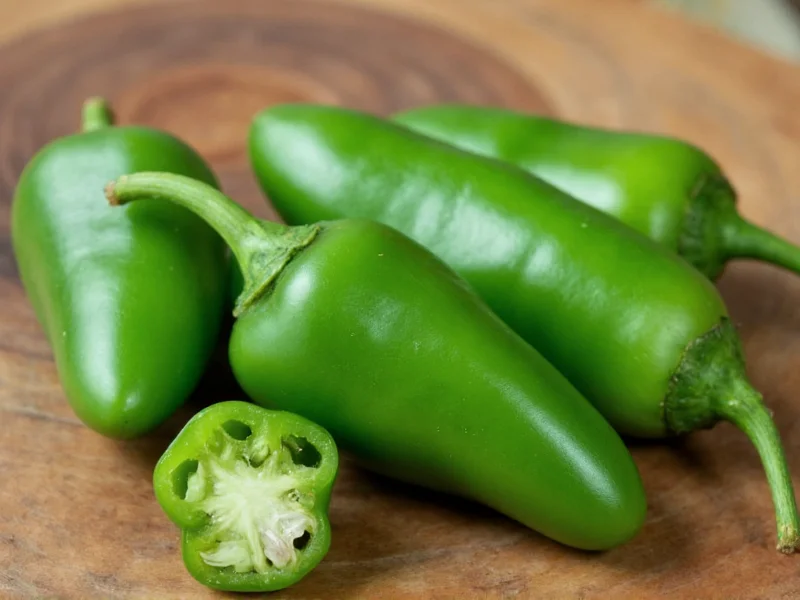When your recipe calls for jalapeño peppers but you're facing an empty shelf at the grocery store or need to adjust the heat level, knowing reliable alternatives becomes essential. Understanding the unique characteristics of jalapeños—their moderate heat (2,500-8,000 Scoville units), grassy flavor, and firm texture—helps identify the most appropriate substitutes for different culinary applications. Whether you're making salsas, stuffed peppers, or adding spice to soups and stews, the right alternative maintains your dish's integrity while accommodating ingredient availability or personal heat preferences.
Understanding Jalapeño Pepper Characteristics
Jalapeños occupy the middle ground of the chili pepper heat spectrum, offering noticeable but manageable spice. Their flavor profile combines grassy, vegetal notes with subtle fruitiness, especially when ripe (red jalapeños). The thick walls provide satisfying texture in both raw and cooked applications. When seeking substitutes for jalapeño peppers in recipes, consider three critical factors: heat level, flavor profile, and texture. The ideal replacement depends on whether you need the pepper raw (in salsas or salads), cooked (in sauces or stews), or pickled (for garnishes or sandwiches).
Best Substitutes by Heat Level
Choosing the right jalapeño pepper substitute requires matching the heat intensity to your specific needs. For those seeking similar heat with nuanced flavor differences, Fresno peppers provide an excellent 1:1 replacement with their comparable Scoville rating (2,500-10,000 units) and slightly fruitier profile. Serrano peppers, running hotter at 10,000-23,000 Scoville units, work well when you want increased heat—use half the amount called for in your recipe. For milder alternatives, poblano peppers (1,000-2,000 units) offer earthy flavor with significantly less heat, while banana peppers (0-500 units) provide tangy sweetness with minimal spice. Understanding these heat differences is crucial for successful jalapeño pepper substitution in sensitive dishes like cream-based sauces or delicate salsas.
| Pepper Variety | Scoville Units | Flavor Profile | Best Substitute Ratio | Ideal Applications |
|---|---|---|---|---|
| Jalapeño (reference) | 2,500-8,000 | Grassy, vegetal, slightly fruity | 1:1 | All-purpose, salsas, poppers, pickled |
| Serrano | 10,000-23,000 | Grassy, bright, more intense heat | 1:2 (use half) | Salsas, hot sauces, marinades |
| Fresno | 2,500-10,000 | Fruity, slightly smoky | 1:1 | Salsas, relishes, fresh applications |
| Poblano | 1,000-2,000 | Earthy, mild, slightly sweet | 2:1 (use double) | Stuffed peppers, rajas, soups, mild sauces |
| Banana | 0-500 | Tangy, sweet, minimal heat | 3:1 (use triple) | Pickled applications, salads, sandwiches |
| Habanero | 100,000-350,000 | Fruity, floral, extremely hot | 1:10 (tiny amounts) | Hot sauces, extreme heat applications |
Cooking Method Considerations for Jalapeño Substitutes
The cooking method significantly impacts which jalapeño pepper substitute works best. When using peppers raw in salsas or salads, freshness and crisp texture matter most—Fresno peppers excel here as the closest flavor match. For cooked applications like sauces, stews, or roasted dishes, consider how heat transforms each variety. Poblano peppers develop rich, complex flavors when roasted, making them ideal substitutes for recipes featuring roasted jalapeños. In pickled applications, banana peppers provide similar tanginess with less heat, while serranos maintain their crispness better than jalapeños during the pickling process. For stuffed pepper recipes, poblano's larger size and thicker walls make them superior substitutes, though you'll need to adjust cooking times due to their density.
Recipe-Specific Substitution Recommendations
Certain dishes demand specific considerations when finding substitutes for jalapeño peppers. For authentic salsa verde, serrano peppers provide the necessary heat and grassy flavor, though you should reduce the quantity by half. When making jalapeño poppers, poblano peppers work surprisingly well despite their milder heat—their thicker walls hold up better to baking and frying. For canned jalapeño substitutes in recipes like nacho cheese sauce, consider using pickled banana peppers for similar tang with less heat, or roasted poblano peppers in adobo sauce for deeper flavor. In ceviche or fresh pico de gallo, Fresno peppers maintain the necessary crisp texture and moderate heat. When substituting in cream-based sauces like jalapeño ranch dressing, banana peppers provide the ideal mild tang without overwhelming the delicate dairy flavors.
Non-Pepper Alternatives for Special Dietary Needs
For those avoiding nightshades entirely or needing completely heat-free alternatives, several options exist. Black pepper combined with a touch of vinegar can mimic jalapeño's heat and acidity in some applications. Horseradish offers pungency without the nightshade family connection, though it lacks the vegetal notes. For smoky depth without heat, smoked paprika provides complexity in sauces and stews. In creamy applications like dips and dressings, a combination of mustard powder and lemon juice creates similar tangy heat. When substituting for pickled jalapeños, consider capers or chopped green olives for briny flavor notes. These alternatives won't perfectly replicate jalapeños but can provide functional substitutes when peppers aren't an option.
Storage and Preparation Tips for Substitutes
Proper handling maximizes your jalapeño pepper substitutes' effectiveness. Store fresh peppers in the crisper drawer of your refrigerator in perforated plastic bags for optimal humidity control—most substitutes last 1-2 weeks this way. Freeze roasted poblano or serrano peppers in airtight containers for up to 6 months, ideal for future sauce making. When preparing hotter substitutes like serranos, wear gloves to prevent skin irritation and always remove seeds and membranes to reduce heat. For milder substitutes like poblanos, roasting and peeling enhances their natural sweetness. Remember that heat concentration varies within the same pepper variety—always taste a small piece before committing to your recipe. When substituting in large batches, test with a small portion first to ensure the heat level meets your expectations before proceeding with the entire recipe.











 浙公网安备
33010002000092号
浙公网安备
33010002000092号 浙B2-20120091-4
浙B2-20120091-4